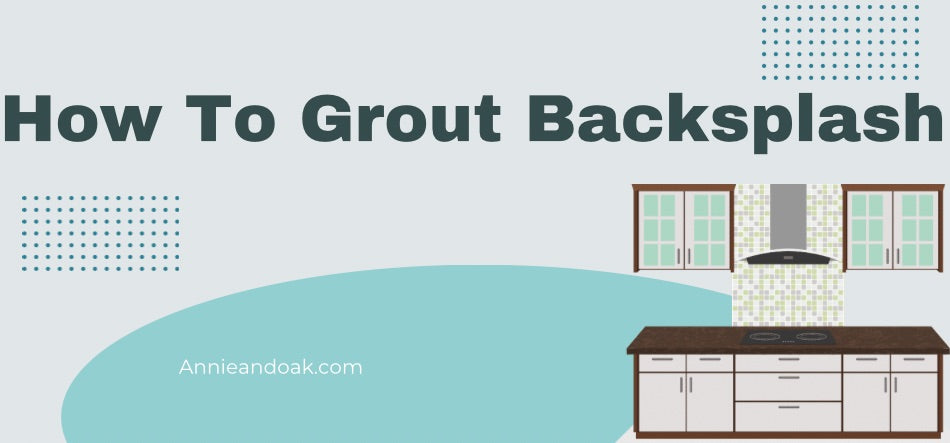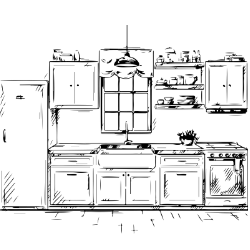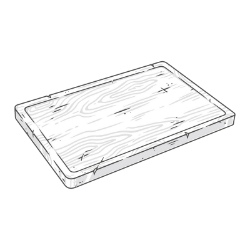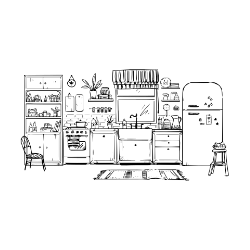
How To Grout Backsplash

Creating a tile backsplash in your bathroom or kitchen is a rewarding but time-consuming 3-step process.
Prepping the drywall and placing the tiles are fairly straightforward elements of creating a backsplash, but grouting the backsplash is the part of the project that often causes problems for DIY home decorators.
Unfortunately, messy grouting can ruin the overall look of your backsplash, and if you don’t complete the grouting correctly, your tiling won’t be sufficiently reinforced and may get damaged more quickly.
Luckily, there is an easy, step-by-step process you can follow to ensure that your grouting looks good and holds up for years to come.
We’re going to be outlining that process for you today, so read on to learn how to grout a backsplash to a professional standard!
You Will Need
Grouting a backsplash is a task that will require your full attention and consistent focus throughout, so you don’t want to be searching around your home for your tools halfway through the process.
Bearing that in mind, before you start grouting your backsplash, make sure that you have the following tools and materials ready:
- Your chosen grout (see below)
- Grout sealer (if necessary)
- Grout float
- A plastic sheet
- Caulk
- Painter’s tape
- A putty knife
- Bucket x 2
- A cloth
- A sponge
Choosing Your Grout
In addition to making sure you have all the tools and materials you need, you will need to choose the right grout for your project.
The type of grout you will need to use for professional and long-lasting results will depend on how much space you have left between the tiles in your backsplash.
It will also depend on other factors such as the room in which you’re creating your backsplash and what kind of tiles you have used.
Here are the various types of grout you can use to finish your backsplash and when each one is recommended:
- Finely Sanded. If the gaps between the tiles in your backsplash are between ⅛ and ⅜ of an inch wide, the best grout type for your project will probably be finely sanded grout. Finely sanded grout contains small quantities of sand which stops it from shrinking and allows it to last longer.
- Unsanded. Unsanded grout is the best type of grout for tiled backsplash with narrow seams where shrinkage (which sand usually prevents) isn’t so much of an issue. It’s ideal for seams that are no more than ⅛ of an inch in width.
- Epoxy. If you are creating a backsplash in your kitchen, you may prefer to use epoxy grout. This is because other types of grout can be negatively affected by the grease and acids that are produced during cooking. However, the downside of using epoxy resin as grout is that it dries very quickly, making it difficult to produce professional-looking results.
- Quarry. Quarry-type grout is a popular type of grout that is made from cement. This grout is ideal for heavy terracotta tiles or backsplashes with wide seams of up to ½ an inch.
Grouting Backsplash: Step-By-Step

Now that you have chosen the best grout for your backsplash and made sure that you have easy access to all the right tools for your project, it’s time to get started!
Here are 9 easy steps to achieving the perfect grouting for a backsplash:
1. Put Down The Plastic Sheeting
The first thing you will want to do is lay plastic sheeting over any surfaces in the room that are close to your backsplash and that you don’t want to mess up with grout.
Put your plastic sheet on any countertops you want to protect and secure it in place using the painter’s tape.
2. Mix The Grout
Now it’s time to mix your grout. Take one of your two buckets and your putty knife and stir the grout until you notice a change in its consistency.
Ideally, the consistency of your grout should be similar to peanut butter, so don’t stop mixing until it has thickened sufficiently.
Try not to put more grout in your bucket than you need to use because the leftover grout will harden.
3. Start Applying The Grout
Once your grout is mixed to a peanut butter consistency, you can start applying it to the backsplash.
Using your putty knife, take a small amount of the grout and carefully apply it between the tiles.
You should hold the knife at a 45-degree angle and work in upward strokes since this is the best way to ensure accurate placement of the grout.
4. Let The Grout Dry
Now that you’ve applied grout to all the seams between the tiles in your backsplash, you should allow a short 15-minute drying period to let it settle.
Don’t let it dry for longer than this, however, since there are some other steps you need to complete before the grout dries properly.
5. Remove The Excess

To remove any excess grout from your tiles, you will need to take the second bucket and fill it with some warm water.
Now, dip your cloth into the water and gently wipe away any grout that isn’t within the seams between the tiles.
6. Allow More Drying Time
At this point, you should allow a few more hours for the grout to dry more permanently.
7. Remove Grout Film
After a few hours have passed, you might notice some grout film remaining on the tiles of your backsplash.
Take your cloth with warm water again and wipe away the film, leaving clean tiles behind.
8. Apply Grout Sealer (If Needed)
If your chosen grout calls for grout sealer, you should apply this product after 24 hours. You must let the sealer cure fully before you can finish the process and start using the area.
9. Caulk the Edges
The final step in the process of grouting your backsplash is caulking the edges of the tiled area where it meets countertops or windows.
Make sure to caulk the corners of the backsplash carefully. Once the caulk has dried, your project is complete!
Final Thoughts
Thank you for reading our guide to grouting backsplash! Hopefully, our step-by-step outline has simplified the process and you’ll love the finished result!





